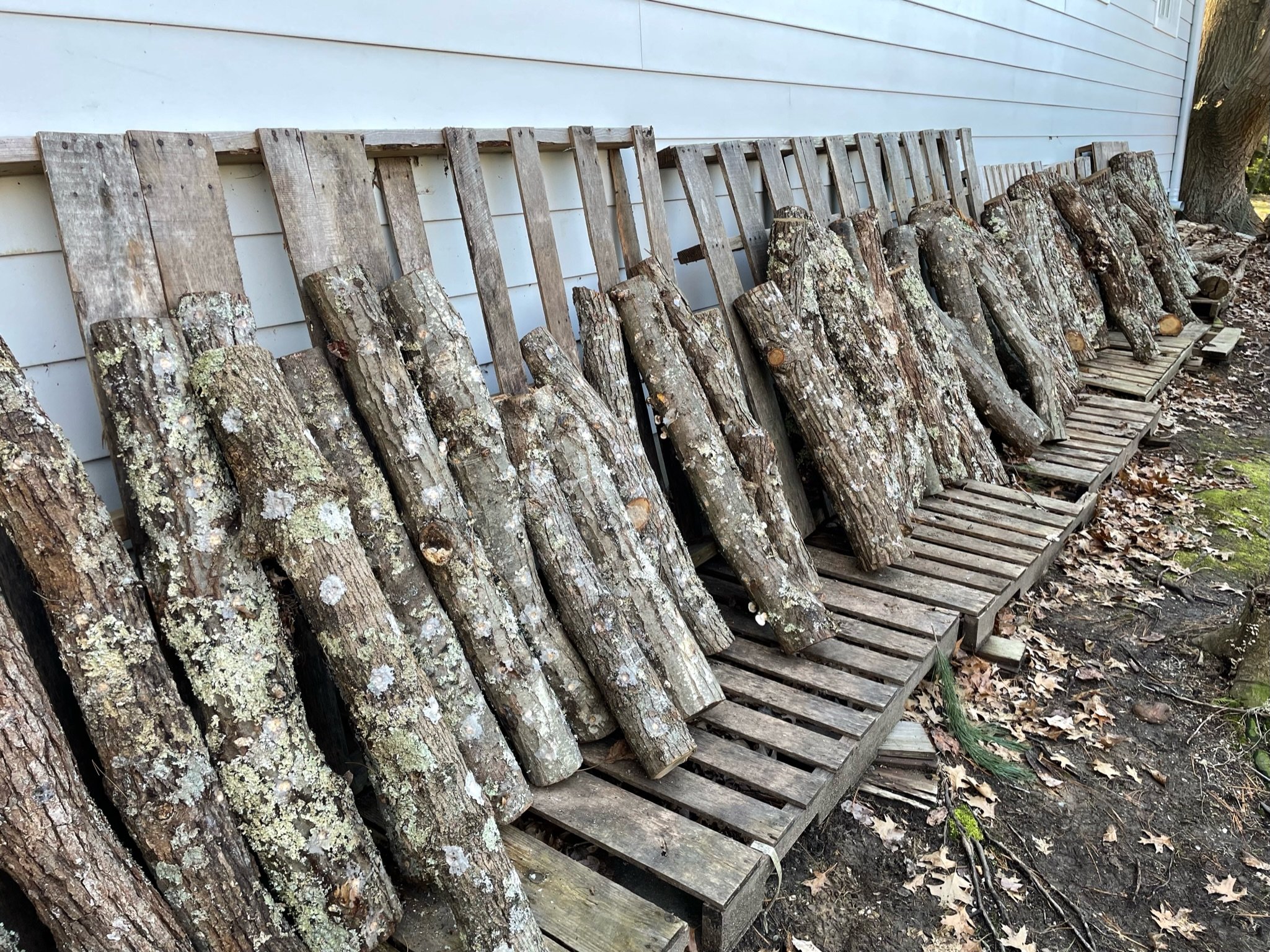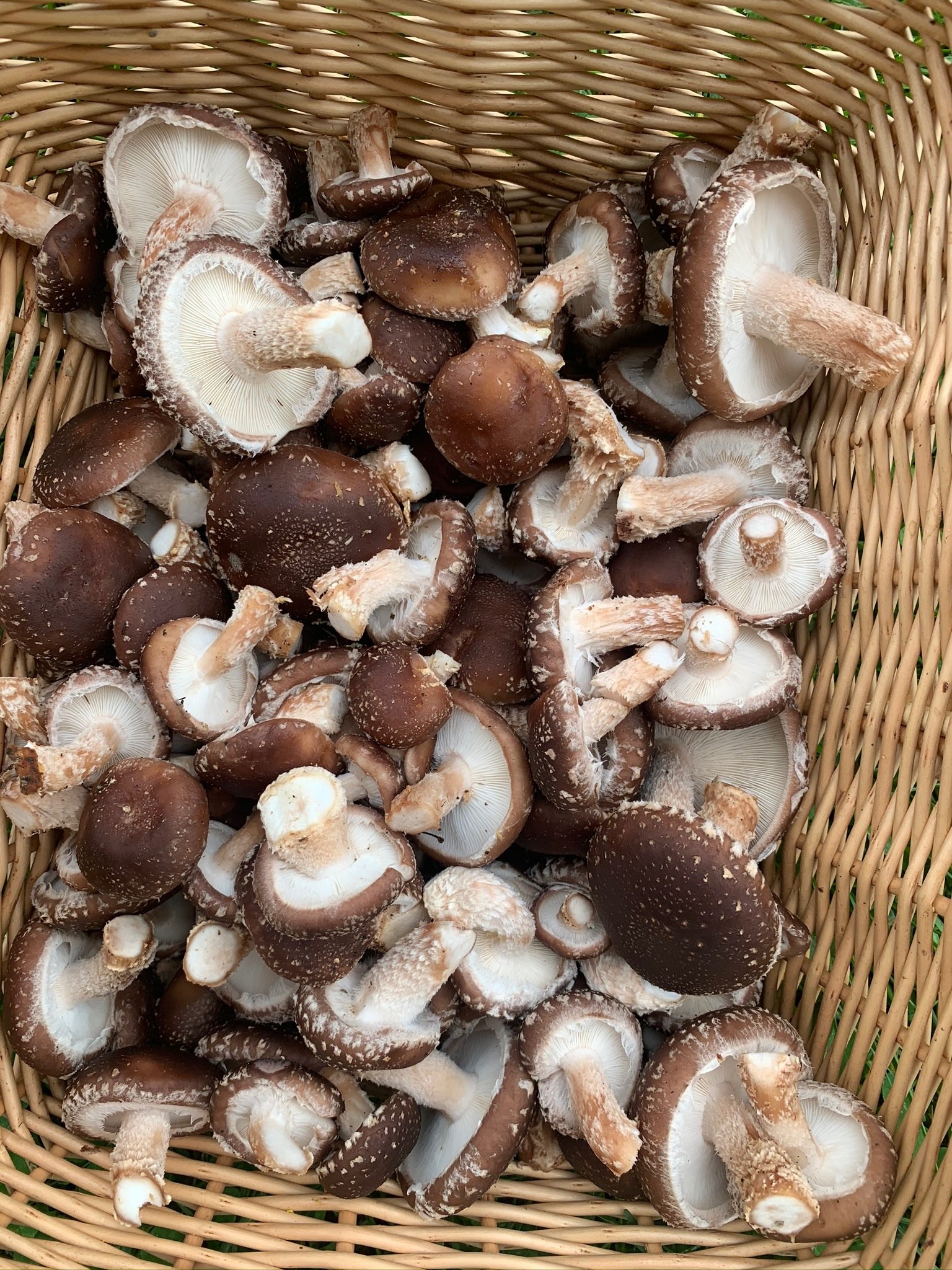Mushrooms at Home
We are excited to be growing mushrooms again this year at Valentines! We chose shiitake for their mild earthy flavor, excellent versatility, caramelization qualities, and their nutritional content. Though we don’t all have the time and space to grow logs of mushrooms at home, we thought we’d share some ways you can join in too!
See below for some terms, notes, and different methods of growing, as well as why mushrooms are worth incorporating into your life (if you enjoy eating them)!
Bonus: check out some of our favorite mushroom recipes to put your hard work to good use and to really impress your loved ones.
TERMS TO KNOW
Spores - the “seed” from which mushrooms grow, which is not actually a seed at all.
Substrate - the medium that mushrooms grow in. Depending on the varietal, this could include compost, manure, coconut hulls, cocoa seeds, corncobs, cardboard, sawdust, grain, straw, wood chips, or on logs.
Mycelium - the white, web-like structure that forms from spores growing within a given substrate. These fine, “root-like” hairs are intelligent networks of information and nutrients that mushrooms grow from.
Spawn - the inoculated substrate with mycelium before small mushrooms begin to form, called primordia.
COMMON TYPES OF MUSHROOMS
Though there are many kinds of inedible mushrooms to be aware of, there are so many edible mushrooms that are delicious, easy to grow, and readily available in the grocery store and at farmers markets. Whether you’re choosing them off the shelf or picking them up from a booth at the market, here’s a short guide to some common varieties you might see!
Shiitake mushrooms: With a tender, meaty texture, shiitake mushrooms are amazing when cooked and again, are the type we grow on our logs. They are versatile and are best sautéed, fried, stir-fried, roasted, and added to whatever savory dish that’s in need of an earthy boost!
Oyster mushrooms: Light in color and flavor, oyster mushrooms are sweet and mild. You’ll see them most often in stir-fries, and soups, and our favourites are a beautiful pink hue that’s truly a sight to see!
Cremini mushrooms (which are also portobello and button at different life stages): Probably the most common mushroom you’ll find on pizzas and salads. Best cooked as opposed to raw, they’re often great in meatloaf / meatballs for an added veggie serving - throw them in the food processor until they’re a fine dice and add it to whatever ground meat you prefer!
Lion's mane mushrooms: These stringy, almost icicle-like mushrooms are white and have a rich, deep, silky texture and flavor - some even say reminiscent of seafood! These mushrooms also have wonderful medicinal properties too so you’ll find their name a lot in the supplement section.
Maitake mushrooms (also hen-of-the-woods): With elegant fan-like form, almost like frisee lettuce, maitake mushrooms are delicate and delicious and are native to the northwestern US as well as other parts of the world!
IMPORTANT NOTES
Mushrooms are sensitive to bright light, hot temperatures, and too much / too little water.
Outside, mushrooms can take a longer time to flourish due to the lack of a controlled environment - this means growing mushrooms indoors in a controlled environment can be even more successful than outside. It also reminds us just how incredible they are for surviving and thriving - it’s almost magic!
Only purchase spores, kits, and equipment from reputable / tested sources. Mushrooms are very powerful and can be extremely dangerous so it’s important to take caution.
When foraging, it’s imperative you go with an expert as to not easily mix up mushroom varieties.
See some resources for grow kits below:
METHODS
Mushroom Grow Kit (see above)
DIY At-Home Mushroom Growing (see below)
Mushrooms on Logs (what we do at Valentines)
WHAT YOU’LL NEED
A Mushroom Grow Kit
OR
A shallow planting tray - approx. 6” deep - common sizing 14 x 16” - of wood, metal, or plastic. Substrate
Spores or Mycelium
Spray bottle, fine misting attachment for a hose, or damp towels
Heating mat / warm, dark space
Optional soil thermometer
Potting soil
DIY At-Home Mushroom Growing
Step 1: Inoculate the Substrate
Let’s start with cremini / white button mushrooms. Purchase and inoculate as per directed by the trusted mushroom purveyor. For example, cremini grow on composted manure, shiitakes on wood or hardwood sawdust, and oyster mushrooms on straw.
Step 2: Make Sure To Keep Desired Moisture At All Time
At this stage, it’s essential the substrate remains moist throughout the growing process, but not too wet. Foragers will know by the weather conditions when to go mushroom hunting because they know to watch for spells of damp weather, increasing the likelihood of mushrooms! Use your fine mister, spray bottle, or damp towel to ensure the substrate is moist at all times.
Step 3: Incubate
For approximately 3 weeks, the soil must be constant at about 70* F to promote growth. Using a germination mat / chamber, or a warm (dark) place in your house will do just fine. Make sure not to overheat though - they’re sensitive!
Step 4: Tend the Mycelium
Lower temp between 55 and 60*F once the mycelium covers the top of the tray - a web of white, a network of “root-like” fibers. This may mean removing the heating pad if your place is warm enough - you can use your soil thermometer to keep track of this! Cover with about ½” of potting soil and within a few days, you should start to see tiny mushrooms peeping up out of the soil. Remember to keep conditions sterile (like hands, tools, materials) so you are only encouraging the spores to grow, not other things!
Step 5: Harvest!
Button mushrooms are good to harvest after 3-4 weeks. You’ll know when they’re ready when the tops are separate from the stems, making the mushroom shape - you’ll know because they’ll look like the ones you buy! Harvest your mushrooms with a mushroom harvesting knife or with a sterilized paring knife (fresh from the dishwasher or swished in boiling water for a few minutes. Do not pull mushrooms from soil as you will disturb the mycelium and other mushrooms growing!
They are the gift that keeps on giving as mushrooms can regrow for up to 6 months - see how long you can tend to and grow your mushrooms. When watering your mushrooms be sure to not water from the top - keep the water as close to the soil as possible and do not overwater - a little goes a long way!
MUSHROOMS ON LOGS
Somewhat similar to the substrate method above, think about our logs taking the place of the trays and growing medium. We soak our mushroom logs weekly on a rotation. Each week we fill a water basin and soak about 7-10 logs at a time for a 24-hour period. This is a way to help force the logs to fruit and produce much more quickly - simulating a rainy period in nature. We succession the logs we soak so that we have a more reliable supply of mushrooms rather than large waves and sporadic droughts of them. At home, you learn what works for you, too, and if you’re growing indoors you’ll have more control over the timeline of your mushrooms.
MUSHROOM NUTRITION
Long-touted for their powerful effects, mushrooms’ healing and cleansing properties are becoming more and more popular and they can be found in all forms from powder to pill to tincture, they’re really on the rise! Did you know there are over 10,000 varieties?
Mushrooms are neither a plant nor animal as you might know - they’re a fungus! A substance called ergosterol, is responsible for the vitamin D content in mushrooms. When exposed to UV rays, mushrooms make vitamin D - a necessary fat-soluble vitamin we need to thrive.
In addition, mushrooms contain:
B vitamins
Phosphorus
Selenium
Copper
Potassium
Beyond what they provide nutritionally it’s more their non-nutritive substances that give them the biggest leg up – “polysaccharides, indoles, polyphenols, and carotenoids in which cell and animal studies have shown antioxidant, anti-inflammatory, and anticancer effects”
Additionally, mushrooms are known to contain an amino acid called glutamate often referred to as “umami” the savory, “meaty”, delicious taste also from tomatoes, soy sauce, seaweed, miso, etc.
MUSHROOM STORAGE & RECIPES
Store mushrooms in the fridge for up to a week but do not wash or clean until just before cooking. Remove any plastic packaging if you buy them in the grocery store, and store in a clean brown paper bag with the top loosely folded to keep them in their highest quality. Mushrooms do not freeze well due to their high water content!
Let’s get cooking!
Resources for this blog:
https://www.masterclass.com/articles/how-to-grow-mushrooms
https://www.hsph.harvard.edu/nutritionsource/food-features/mushrooms/






